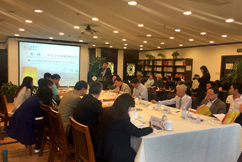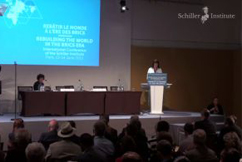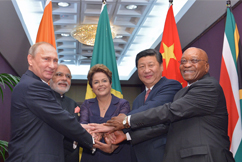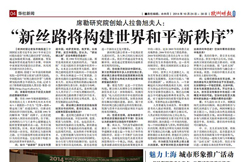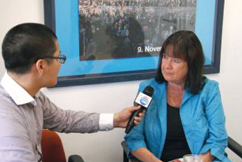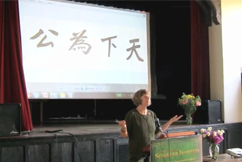EIR’s Special Report “The New Silk Road Becomes the World Land-Bridge” in Chinese Version Presented At Beijing Press ConferenceSeptember 29 – At a press conference today in Beijing sponsored be EIR and the Chongyang Institute for Financial Studies, Helga Zepp-LaRouche, the President of the Schiller Institute and William Jones the Washington Bureau Chief of Executive Intelligence Review were keynote speakers, […]
Continue readingCategory Archives: World Landbridge
Schiller Institute Conference in Paris: Rebuilding the World in the BRICS Era
On June 13 and 14, 2015, eminent representatives of three of the five countries which make up the BRICS (Brazil, Russia, India, China, and South Africa)—and of countries associated with them, were invited to Paris, to speak at an exceptional international conference of the Schiller Institute on the theme: “Rebuilding the World in the BRICS Era.” The aim of this […]
Continue reading→New Paradigm for Civilization
You probably don't know about it yet because the mass media are not covering it but in reality mankind has entered a completely new era already in BRICs countries. They are in process of realizing a completely new economic and financial system. China is building a new silk road which brings development and peace to all the countries which participate in it. China's culture is oriented towards a better future of mankind and the entire Chinese population is optimistically participating in that joint mission. The Indian Prime Minister, Modi, has expressed it this way. The BRICs countries are the first alliance in history which is not defined by its present capacities, but by the potential of the future and that is the creativity of its people. Let us do everything to get the European nations and the United States to join in this optimistic perspective for the future.
New Perspectives on the Western Water Crisis
MEMO FOR THE NEXT PRESIDENT New Perspectives on the Western Water Crisis
Continue reading→The U.S. and Europe Must Have the Courage to Reject Geopolitics and Collaborate with the BRICS
In today’s nuclear age, the consequence of a geopolitical policy of confrontation with Russia and China can only be the thermonuclear extinction of the human race. Therefore, every effort must be made to cooperate to solve the multiple crises facing humanity. The BRICS nations (Brazil, Russia, India, China and South Africa) have united to pursue a policy of economic development […]
Continue reading→One Belt One Road & New Thinking With Regard To Concepts And Practice
"'One Belt and One Road' & New Thinking With Regard To Concepts And Practice"
Prof. Shi Ze,Director for International Energy Strategy Studies, and China Institute of International Studies Senior Fellow, Beijing, China
October 19, 2014 Schiller Institute International Conference "Mankind is the Only Creative Species! The New Silk Road and China's Lunar Policy"
English Transcript:
Honored Schiller Institute President Madam LaRouche, honorable experts, distinguished friends, hello. I am from Beijing, China, a senior research fellow of the China Institute of International Studies. Today, I’m very happy to be able to attend the Schiller Institute’s 30th anniversary activity. I must, towards the Schiller Institute and Schiller Institute President Madam LaRouche, for her earnest invitation, express my deeply felt thank you.
Within China, I’ve attended many conferences on “One Belt and One Road”. However, this is the first time that I’ve attended a conference outside of China that touches upon China’s governmental policy and international diplomacy. So, very importantly, I must earnestly express my heartfelt thank you to Madam LaRouche, for having provided me with such a great opportunity to introduce to you the relevant concepts and thoughts of our “Silk Road Economic Belt”.
Madam LaRouche is someone who, in China, is received by everyone as a much liked and respected social activist. I have, in many of China’s media outlets, read her speeches and interviews. Her expert opinion regarding China is something that I deeply respect. And as a friend of China and the Chinese people, she has provided many sincere and earnest ideas towards China’s development. So, we very much honor and respect such an old friend of China.
Today, I will discuss some of my thoughts on the “New Silk Road Economic Belt” innovation. Everyone knows that in 2013, our Chinese leader [President Xi] presented two very important development proposals: the Silk Road Economic Corridor and the 21st century Maritime Silk Road. These two new proposals, are to develop and deepen cooperation in a new form, and have very meaningful implications for the development of the relationships between China and the other nations along the New Silk Road. So, how do we actualize these proposals that China’s leader proposed? Well, first, from the standpoint of ideas and concepts, we must have innovation. In the detailed development of the New Silk Road Project, we must also have innovation in the implementation. So the topic of my speech today is “Silk Road Economic Corridor and the Innovations on its Conceptualization and Implementation”. I’d like to discuss its four main points.
First point, the innovation in conceptualization/outlook
In the innovation of conceptualization, I’d like to emphasize three areas. Firstly, China in the course of its “reform and opening up”, initially adopted a “bringing-in” strategy, that is, to attract outside countries’ technology and investment to do development in China. We call it a policy of “hitching a ride,” to draw in support from international assistance to push forward our economic development. This kind of policy in the beginning of our opening up of China achieved obvious results in developing China. A lot of international financial organizations and friendly nations came to China to invest and engage in economic cooperation. The second phase, is the “going-out” strategy. That is, to better accelerate the development of China’s economic policies, we pushed for our Chinese companies and enterprises to go out, to go out abroad to do international development, to develop everywhere in the world; to go out for international economic cooperation. This, I think had very obvious results in the recent past. This very well used national resources to go aboard and allow Chinese enterprises to learn more advanced technology. This advanced our R&D capability and facilitated the foundation for our own advancement. So in the ‘walking out”, we broadened and expanded the scope of our “reform and opening up”, increasing the scale and the momentum of economic development. At this point, the central government proposed the New Silk Road Economic Development Corridor —the “One Belt and One Road” strategic concept, which lawfully took the foundation brought about from the “bringing-in” and the “going-out” strategies, and both expanded and merged the two concepts. So, when China’s friends study our “One Belt One Road” development proposal, this policy possesses a much broader and richer conceptual significance. This is the first, the innovation on the conceptual level.
The Second Innovation in Conceptualization: following China’s own economic development, in what way do we adapt to the needs of our own “reform and opening up”, while at the same time interacting in a process with the countries on our periphery and along the Corridor, giving them a share in the benefits of our own development, and then proceeding in broadening collaboration between China and the other countries of the world, in order to achieve our common development? That is, to allow our cooperation to achieve mutual and equal benefit. This is not that China is alone receiving benefit, but rather, how in our cooperation, we all share in the development dividends. This is a very important shift in development of China’s international policy.
Furthermore, our leaders have brought about new concept on “Benefit”. That is, in terms of “profit/benefit”, to consider how we, in our cooperation with our partners, allow our partners to achieve benefit and development, so that our partners will not receive diminished benefits against what we achieve in the course of our cooperation. This is something that our leaders, especially President XiJinPing, have recently emphasized as the necessary outlook for our cooperation with other nations. And I think that in our “New Silk Road Economic Development”, he also emphasized a very important concept—that this kind of development must be both balanced and equal; that this is not only China having increased development in both its own scope and quality, but rather, that in the course of this cooperation, it will allow our partners to benefit from a parallel as well as equal scope and quality of development as China. This is important, because recently some friends have said to me that China’s proposal of the New Silk Belt only considered how it will be beneficial to China. I think that is only half right. That is, any proposal for China’s international development project will, of course, consider the benefit that it will have for China. But in that course, we are also considering its benefit to our cooperative partner, and that it is both a mutual and equal pace of development for our partners. I think that this equal development for our partners is a very important point to emphasize for the “One Belt One Road” policy and development of the New Silk Road Economic Development.
Thirdly, in sponsoring the “One Belt One Road” policy, our leader emphasis the concept of the “Three No’s”. That is, first, we do not interfere in the internal affairs of other nations; second, that China does not seek to increase the so called “sphere of influence”; and third, China does not strive for hegemony or dominance. That is, we are all equal partners. So our leaders are proposing this “three No’s” concept. I think that for all of our friends present today at this conference, this is something to heavily empathize about China’s foreign policy and to emphasize that such policy is on the basis of “peaceful development” with others.
I think that the promotion of the New Silk Road Project reflects how China seeks to position itself internationally—to propose such an important concept and such an innovative proposal, China is proposing a stand on how we seek to align ourselves in our relationship with the international community. This is to say, after the Cold war, in the Eurasian region, we are seeking to provide equilibrium. In this area, all the major countries, including China, Russia, United States and European Union, there exists a situation of checks and balances between the major powers where not one single major country in Eurasia has dominance. That is, be it United States, Russia, or China, or the EU, none in the Eurasian area should have a dominating or hegemonic position. China’s goal, in promoting the “One Belt and One Road”, is not to disrupt this equilibrium in the Eurasian area, but rather, to ensure the stability of this area. We seek that each region form and develop mutual assistance, mutual friendship, and mutual cooperation. This, I think, is a necessary development, is a necessary basis, and pre-condition, as well as reason for our development of the New Silk Road Project.
I would like to say a few more words about the fact that in the Eurasian region, there are many regional economic cooperatives, including the Russian-led Eurasian Economic Union, the Shanghai Cooperation Organization, the South Asian Association for Regional Cooperation (SAARC), the Organization of Islamic Cooperation, and other European cooperative organizations. What is the relationship among these organizations? I don’t think that these organizations are there to negate or work against each other. Rather, I feel that these organization are there to learn to work with, to cooperate with each other, to benefit from each other. To motivate each of these cooperatives to investigate in our mutually beneficial development. Only that way, can our New Silk Economic Corridor have real development. So, I feel that our New Silk Road Economic Corridor is a proposal that is of the nature of spearheading and opening possibilities rather than the closing or blocking out of relationships. Today in the audience, we have mostly European friends, and our New Silk Road Economic Corridor’s basis is that Europe will be at one end of its center and China at the other end. It’s just like a linked dumbbell; the development of this corridor between China and Europe not only will strengthen both Europe and China on each end, but will bring about the social and economic development in the whole of all of the regions of Central Asia, South Asia, Middle East and Eastern Europe. So, I think that the New Silk Road Economic Corridor can have direct impact and importance to the European nations. The European nations in this regard, already have a great foundation in their technological basis and the New Silk Road Corridor is something that we think will greatly develop all of these nations. Again, we must emphasize that in promoting the New Silk Road Corridor, we seek friendly cooperation with all major nations on concept of “求同存异”—finding common ground while existing differently—especially the seeking of common ground. This is central to our conception. So, we do not oppose the United States joining us in this, or Russia or European nations. We welcome all nations. That is why this proposal is inclusive and open.
This is my first major point. My second major point is that for our New Silk Road Corridor’s “One Road One Belt” Concept, I’d like to emphasize the question of how to innovate on a model of cooperation.
How do we advance the building of “One Road One Belt”? Typically, whether in discussions inside or outside China, when people talk about the overarching idea (理念) of the New Silk Road, the discussion centers more on the practical concepts (概念)―when China makes the proposal, what is the content of its proposal, as in “what regions will it cover”, or “what is China’s goal”. But what we often leave out is, how do we cooperate together? That is, what is the model for cooperation? How do you develop cooperation? If we don’t solve that question, in actuality, this initiative will not be realized.
So, I think that the point to emphasize is that when we consider how we promote the New Silk Road Project–the level of economic development in these areas surrounding the corridor is very different. There are developed nations, large countries, relatively developed nations, and some underdeveloped nations. So under the condition of very large differences in the level of economic development among these nations, to push forward the process of this project, I think, involves high degrees of difficulty. We are not proposing that in the future three or five years, or even ten years, to have already developed the New Silk Road Corridor Project. I think that this is a long-term goal on the part of China. It has no definite end. Where and when we can push forth the cooperation, we will. So, when China promotes the New Silk Road initiative, this not on the basis of force, of forcing anyone. Our cooperation partners are only those who freely and willingly join us in this project. Whoever is interested is welcomed to join us. Also, for those joining us in the project, we want for each side to enjoy equal privilege. So the New Silk Road Project, for any nation, is a development opportunity, utilizing China’s “Opening Up” policy to broaden each other’s economic cooperation. This provides all kinds of opportunity for entrepreneurship and employment.
So what is the cooperative model? In the Eurasian region, the economic development level is varied, unlike the European region which is mostly developed. So in the Eurasian region, the differences is very large and it is something that must be considered. Second, in the course of considering the model of cooperation, when we talk about the Eurasian region, we’re talking about a process of strengthening the region (调壮). It is not like some of the other existing economic regions around world, where the purpose is that of “expansion” or “encompassing”. For example, the ASEAN or EU cooperation or Latin American cooperation, they are all a kind of “encompassing”. However, our emphasis for the Eurasian region is that of strengthening it. So, whether we can use ASEAN or EU or the Latin American experience, I think that we do not exclude their experience. We must study and learn from them. More importantly, we must enjoin the unique potential of our various regions along the corridor. I think the important thing for us is how do we set up our cooperation? That is, this process of strengthening the region, how do we go about it? We cannot simply take from the existing models. Often, economic experts, even our own in China, take the Western European model and attempt to simply impose the whole of that model on the new concept. Well, we don’t reject others’ models, but we must seek to develop new ones. In this regard, I very much hope that our European friends will provide us with their thoughts and new suggestions.
So this New Silk Road Project is very new and this type of cooperative vision has little precedent in world history―the regions that it encompasses are many; the length of the Corridor is very great; the countries that it will reach are many. So, there is no precedent. So the road in front of us is, that we must innovate, we must develop new ideas and thoughts, to find a way that would work for the common goals and aspirations of China, and the nations along the new Silk Road Corridor.
Third point: I like to talk about the content of cooperation for our New Silk Road Corridor
First, I talked about conceptualization and methodology. Now, I will talk about the details of the areas for development, the content of development. First, I must again emphasize, that building the “One Road One Belt” long-term process of development is not something to be finished in a few years. We are very clear about that. There are opportunities and at the same time, there are challenges. So we must retain a clear head about this.
I feel that in the process of building the “One Belt One Road”, in the innovation of the character of its development, there are a few elements that must be noted and emphasized. In accordance with the existing economic foundation and condition, and the pre-conditions of our cooperation, our efforts must first be put to energy resources, the transportation grid, electricity systems, communications networks, other such basic infrastructure platforms, and the networking together of such platforms. There is a saying in China, “to develop wealth, you have to first build roads”. The development corridor’s economy can only prosper when human resources, logistics and economic flow (人流, 物流, 资金流) have all been brought on-line and integrated. These basic conditions must be there.
In promoting the development of the “One Road One Belt”, we are not talking about creating a new cooperation mechanism. I must emphasize this. Rather, we are building on the foundation of existing cooperation and existing regional cooperation, ever expanding the scope. This is a cooperative process, not imposing any specific kind of mechanism over the process. Second, we must improve and strengthen each nation’s development strategy and development planning as well as advance the mutual communication and integration of these improvements. We do this so that nations can understand what each other’s next five-ten-year development goals are, and cooperate on that basis; what areas of your strategy are similar to mine; and we must find particular areas and projects for cooperation on the basis of those mutual and common strategies. China, in promoting the “One Belt One Road”, is not seeking unilateral oneness. We only seek to push forward the process of cooperation. Third, I think that in the course of cooperation, we must walk on the frontier of technological advancement. We must nurture and pay serious attention to the most advanced scientific achievements that are being developed in the world. We must take the existing level of development in the Eurasian region and carry-out large scale cooperation on a non-natural resource-taking and non-energy-resource-taking basis. Because in the Eurasian region, each nation’s economic endowment―its national and natural resources―plays a large role in existing cooperation. So I think that there is not enough cooperation not based on natural resources. This means especially development of agriculture, of infrastructure, of the manufacturing industry, and such areas which I think are all retarded areas of needed improvement. We must emphasize a basis of cooperation based on non-natural resource-taking basis, so that it will allow our economic advancement to reach a new high-standard of cooperation.
Lastly, I must place emphasis on the multi-sided attributes for our “One Belt One Road”. We must emphasize high-level multi-dimensional cooperation. For example, we can and should, for the nations along the Silk Road Corridor, develop the effect of “city alliances”. We should develop urban industry alliances―for example, international railroad associations, international transportation associations and other similar associations, including international cooperative-network associations. That is, to develop cross-regional, existing industry cooperation, so as to develop bi-lateral or multi-lateral cooperative networks and cooperation systems. At the same time, China encourages plans and programs that would develop the “One Belt One Road” proposal even though they do not include China as a participant. So that some of the programs China will not participate in, but such program will be beneficial to all. What we seek is to be able to promote regional development, and any such program that develops regional economy, China supports. It is not that we will only support those programs that China participates in. No: programs that belong to and are developed by others, we also support. So we seek an inclusive and open cooperation framework.
Fourth point: innovation of the System
The “One Belt One Road” is a grand vision. For China, the challenges are great. First, it not only touches on the necessary cooperation of some of the regions and department within China, but also on China’s overseas organizations and entities. It not only concerns the domestic interests and prerogatives of each region and department, but also private and state-owned enterprises abroad, as well as international enterprises with muti-income and profit sources. And we must consider the development of these multi-profit sources. We must consider coordination between these national and international policies. So, in order to facilitate the development of the New Silk Road Corridor, our central government has been compelled to increase the pace and reform of our economic system, so that this system can better facilitate the development of the New Silk Road Corridor.
In promoting the New Silk Road, we have taken examples from how other nations have carried out their international strategy. For example, the United States, in conducting its own “New Silk Road Plan” looked at South Asia and Central Asia as an entity with regard to their own development needs and combined the original Department of Central Asian Affairs and the Department of South Asia Affairs into a single Department of South and Central Asia Affairs. I think that this kind of experience is something that we can learn from. Russia, in order to promote the development of the Far East and regional cooperation created the Ministry for Development of the Russian Far East. In this manner, we intend to be able to take those examples that suit the development of the “One Belt One Road” system and utilize them to develop our proposal. So, in the future, in the course of our development of the “One Belt One Road”, we earnestly hope to work with the international community, the various nations, the different regions, and on the basis of equal and mutual developments, to promote a program that benefits all of mankind. Thank you to everyone!
Zepp-LaRouche: “New Silk Road will build a new world order of peace”
The following is an interview with Mrs. Helga Zepp-LaRouche by reporter Zhang Qiaonan of Guang Hua Media. The interview appeared in the Chinese-language newspaper European Times on Friday, Oct. 24, 2014 Schiller Institute founder Mrs. LaRouche: “New Silk Road will build a new world order of peace.” In State President Xi Jinping’s trip to Central Asia in 2013 he proposed […]
Continue reading→Zepp-LaRouche: The Silk Road Is the Hope for Peace in the World
The following interview with Helga Zepp-LaRouche was conducted by Xinhuanet, in Wiesbaden, Germany, and published on Aug. 7. The article, in Chinese, has been circulated by Xinhua, and picked up by several other Chinese publications, including China Daily. The Silk Road Is the Hope for Peace in the World Xinhuanet, Aug. 7—”Just like the ancient Silk Road, the Silk Road […]
Continue reading→Developing the Pacific and Ending the Grip of Empire
On November the 2nd, 2013, the Schiller Institute held its 6th in a series of international conferences to create a new paradigm for civilization in Los Angeles, California. This series of conferences was initiated by Helga LaRouche about a year ago, when the first such conference was held in Frankfurt, Germany. Over the course of 12 hours event, leaders of […]
Continue reading→
